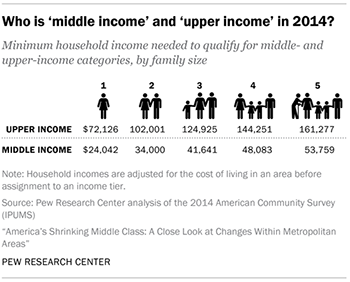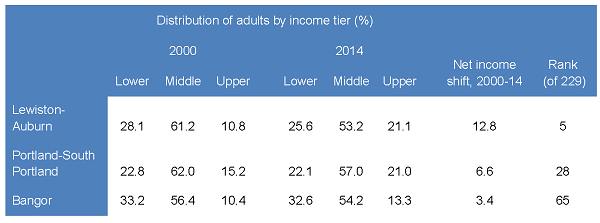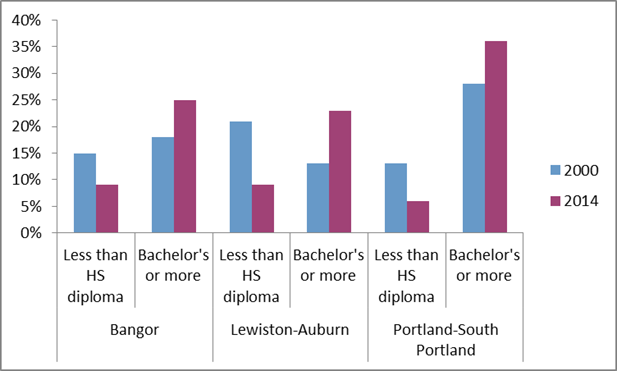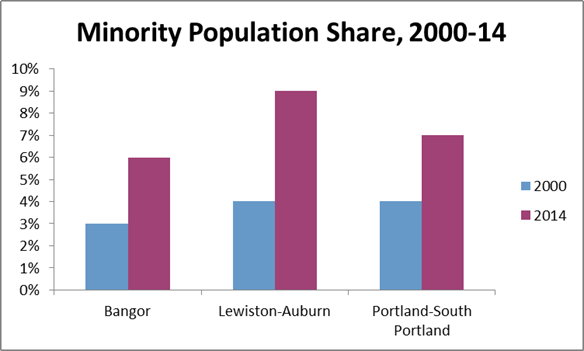The Pew Research Center recently released a report, America’s Shrinking Middle Class, examining the relative proportion of lower-, middle-, and upper-income populations in 229 of the nation’s metro areas.[1] Their findings make for gloomy reading — between 2000 and 2014, the proportion of urban Americans in middle-income[2] households shrank from 55% to 51%. This is a troubling trend, as middle-class Americans are a foundation of our economy. Middle-income families are generally able to afford a decent standard of living and offer their children opportunities for social and economic mobility. Such families also drive much of the nation’s consumer spending which underpins the modern US economy. As the report notes, the shrinking of the middle class in the US over the past decade and a half is one of the key drivers of the narrative on growing income inequality — some people are falling into lower-income brackets, while others are rising into higher brackets. The result is a widening of the gulf between rich and poor. Pew’s research shows that, in some cities, the trends were one-sided, as metro areas slid into economic depressions or experienced economic booms.

The report contains some interesting details about Maine’s three metropolitan areas — Portland-South Portland, Lewiston-Auburn, and Bangor. It’s important to know that these areas are much larger than the cities they are centered on; they are roughly equivalent to Cumberland and York, Androscoggin and Penobscot counties, respectively.
Maine’s metro areas all fared relatively well compared to others in the US. Although all three areas experienced a decline in the middle-class share of their population, all three areas had a larger middle-income share than the national average. What’s more, the middle-class shrinkage in Maine was largely due to people moving into upper-income brackets. The share of the population in low-income households also shrank — albeit very slightly — in each of Maine’s metropolitan areas between 2000 and 2014.

Source: Pew Research Center.
Note: “Net income shift” is calculated by comparing the difference between the upper income share of the population and the lower income share in the two years.
The Lewiston-Auburn area stands out in the Pew report for its growth in upper income households, which was the fifth-highest among the 229 metro areas in the report. Maine’s “Twin Cities” area displays many of the same economic and demographic shifts as the Greater Bangor and Portland-South Portland areas, but to a greater extent.
The report indicates that all three areas also featured a more educated population than before. A small proportion of the population lacked a high school diploma, and a greater share held a bachelor’s degree in 2014, compared to 2000. Since education is the biggest determinant of income and lifetime earnings, this is likely a large factor in the higher income spread. However, there is also a virtuous cycle, as children and adults from higher income households are more likely to complete high school and college educations. In 2000, more residents of Lewiston-Auburn were high school dropouts than college graduates; now that symmetry is reversed.

Source: MECEP analysis of Pew Center data.
Each of Maine’s metro areas also saw a significant increase in the share of its population from an ethnic minority group. Again, Lewiston-Auburn saw the greatest increase in this area, with its minority population share increasing from 4% to 9% over the period. This is the 2nd largest proportional change of the 229 metro areas in the report (Scranton, PA had the largest change). While the minority share of the population in Maine’s metropolitan areas has risen over the past decade and a half, it is still worth noting that Maine remains the “whitest state” in the nation, and that Maine’s metro areas are still some of the least diverse in the Pew report.
The increase in Lewiston’s minority population is primarily due to international migration. The decline in the proportion of Lewiston’s low-income population during this period of migration and demographic change demonstrates that the migration has not created an underclass of low-income residents. Instead, it suggests that the additional population has contributed to the area’s economic growth.

Source: MECEP analysis of Pew Center data.
Note: Minority population is defined as those identifying as anything other than white, non-Hispanic
Caveats and Challenges
One thing to know about Pew’s report is that in the two years they examined, 2000 and 2014, Maine’s economy looked very different. 2000 was a peak year for employment and job creation, while in 2014, the state was still struggling with the effects of the recession. Unemployment in the three metro areas was between 2.5% and 3.4% in 2000, while it was between 4.6 and 5.5% in 2014. These different economies would clearly have had an impact on the household income of families in each year, and may inflate the proportion of the population in lower income brackets, and depress the proportion in the middle brackets for 2014.
It’s also clear that the broad findings on a national level also apply to Maine. The state’s middle class might be stronger than elsewhere, but it has still shrunk over the last decade and a half. This is a period of continued shift from manufacturing to service industries, and the closure of many of Maine’s larger and long-established employers, especially pulp and paper mills. The report also raises a warning flag for policy makers — while the upward mobility of individuals from middle- to upper- income brackets may be good news, it can also be a contributor to growing income inequality in our state and nation. In 2000, the top 10% of households in Maine’s metro areas had an income that was 6.6-7.6 times greater than the bottom 10% of households. By 2014, that gulf had widened to a factor of 8.5-9.0 times. Those figures are a caution against celebrating the upward mobility of one portion of the population, without addressing the needs of the poorest in our society.
[1] Nationwide, the Census Bureau defines 381 metropolitan areas, each centered around major urban population areas, and can represent a single city, e.g. New York, but more often include a pair of cities, e.g. Lewiston-Auburn, or a city and its suburbs. Pew was able to examine 229 of these 381 areas, due to the composition of their data set, the American Community Survey.
[2] Although class is comprised of many components in addition to income, in this blog post, I follow the Pew report’s lead and use the terms interchangeably for the sake of simplicity.



